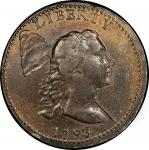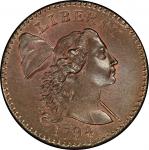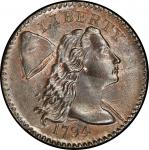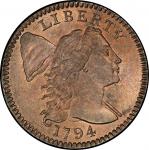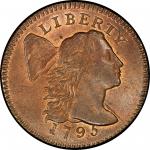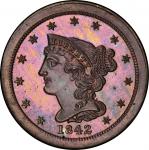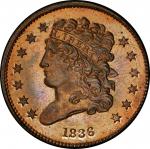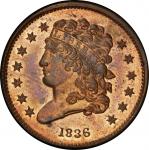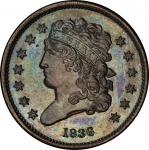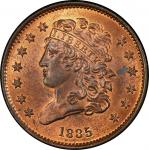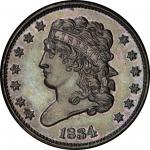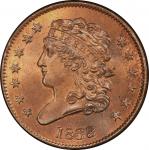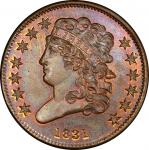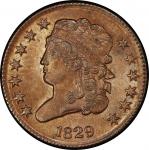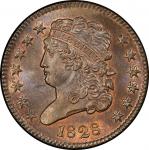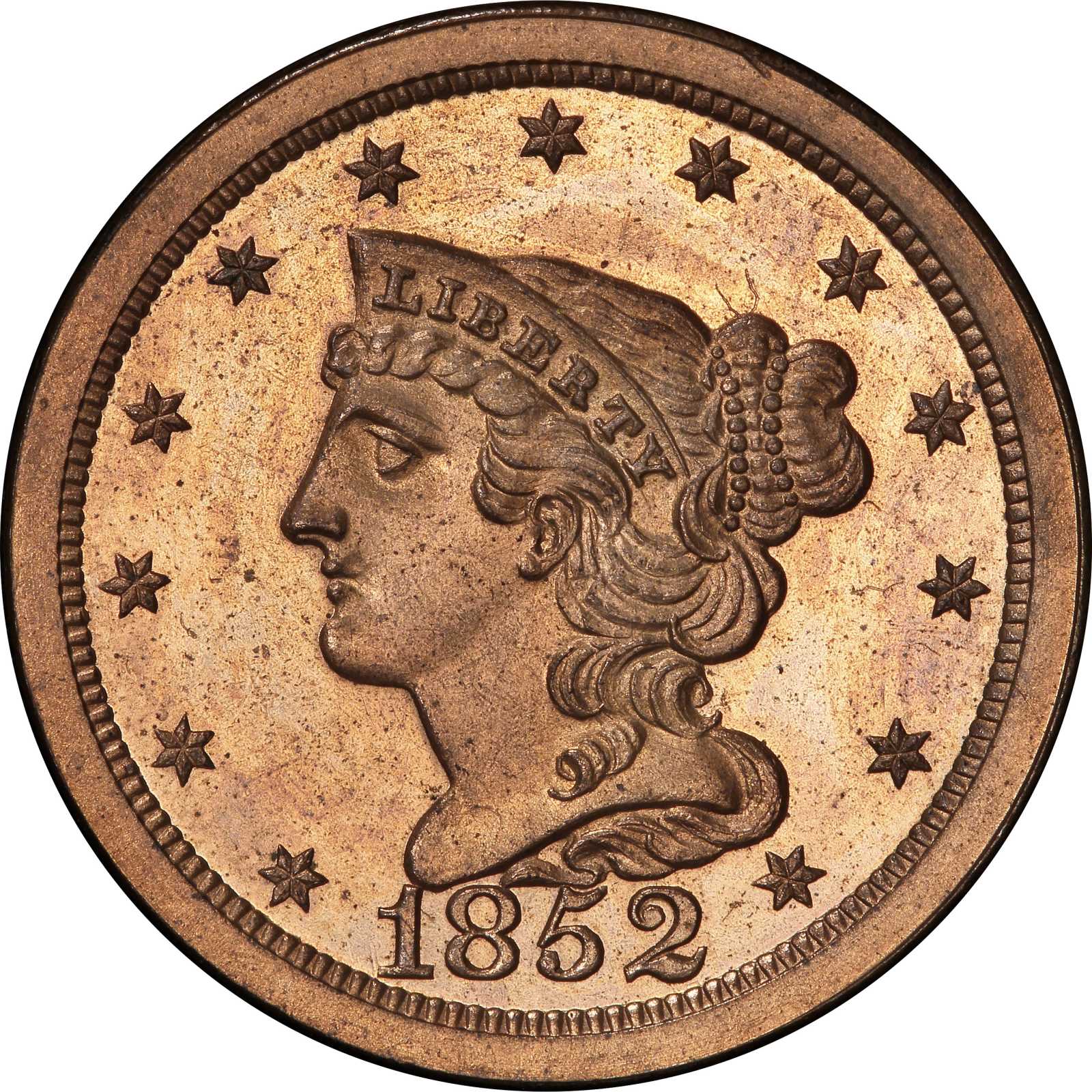Mr. J. Morris the Coin Collector called in the evening & gave me some Coins. - Joseph J. Mickley, June 12, 1852Examination of this coin is a sensory delight, one that seemingly should be accompanied by the rustle of ancient tissue and a waft of dust from a long-untouched pasteboard box. The surfaces show undiminished mint color, fully brilliant and unfaded in their original shade of orange-pink. A glass finds some of the microscopic spots long called "flyspecks," and a somewhat darker area where detritus once rested between the bases of RI of AMERICA, but otherwise magnified scrutiny just reveals the complexity of this coins surface. The beautifully reflective surfaces retain shades of muted pastel violet, an array of fine die lines emerging from the denticles, and a scattering of lintmarks, all embraced by a texture of overall brilliance. The most substantial lintmark is U-shaped, resting above Libertys bun, but several more may be found in the fields and the wide rims beyond the denticles. A raised fin, or wire rim, is seen from 10:00 to 6:00 around the obverse. Beyond some trivial hairlines, there are no flaws worth mentioning.This coin brought $6,000 in the 1969 R.L. Miles sale, a full $1,000 more than Miles specimen of the 1827 Restrike quarter and $1,750 more than a "fully prooflike Brilliant Uncirculated" 1796 quarter sold the same day. It was described at the time as "1852 G.1. ORIGINAL. Large berries. A superb Brilliant Proof in Full Original Mint Color ... This coin is absolutely pristine!" The description went on to call it "probably the Finest Known," superior to the Brobston coin that Stacks had handled six years earlier and finer than the Eliasberg coin that would not spring from a Baltimore bank vault until May 1996, 92 years after its previous auction appearance. When the Eliasberg coin appeared, it shocked most onlookers when it sold for $78,100, despite being graded Proof-63 Brown and cataloged as an "erstwhile Original" and, thus, a likely restrike.The price realized at the Eliasberg sale revealed what many half cent scholars had suspected for some time, an opinion that is now widely held as fact: that the extremely rare 1852 Large Berries Proof half cents are Originals that were coined in 1852. The fact that one of the four examples known is worn and nicked from circulation wear is strong evidence that the 1852 Large Berries coins were struck in 1852, as half cents circulated little after the mid 1850s and almost never after the Civil War. The provenance of this piece allows another piece of evidence to be offered.This coin was sold to R.L. Miles by Harry Forman, the resourceful and entertaining Philadelphia dealer. According to Breens half cent encyclopedia, Forman acquired the coin from another local Philadelphia dealer, C.J. Dochkus, who obtained it from Philip "Piggy" Ward. Ward, best known as a buyer and seller of stamps at the time, has come down through numismatic history as the man who was able to purchase the coin collection of the University of Pennsylvania in the early 1960s. That collection was composed of two 19th century cabinets of incredible importance, both assembled by wealthy Philadelphians. One was gathered by Robert Coleman Hall Brock, whose collecting heyday extended from the mid 1880s to the late 1890s. The other was built by Jacob Giles Morris, a pioneering numismatist who died in 1854. While the coins traced back to Forman, Dochkus, and Ward uniformly come from the University of Pennsylvania, numismatists have too often confused the Morris and Brock collections despite the fact that each tells a fascinating story.Robert Coleman Hall Brock was a wealthy Philadelphia lawyer, collector, and philanthropist. Born in 1861, he graduated from St. Pauls School at 19 and continued his education at Oxford. His passport application described him at 23 as 510", with brown hair, a high forehead, a large nose, and grey eyes. He apparently looked much the same when he died in 1906, at the age of 45. Brocks own father, John Penn Brock, was the last in a line of John Brocks that extended back to the one who immigrated to Philadelphia before 1684. When the father died in 1881, his obituary described "immense coal and iron estates" that gave the surviving generations access to education, travel, summer homes, and all the coins a gentleman could acquire. Robert Brock collected heartily, acquiring enough stamps to be called "one of the wealthiest and best known of American philatelists" in 1894.Brocks interest in collecting seem to have come and gone quickly. He was 33 when he sold his stamps. At the age of 37, he not only donated his collection of coins to the University of Pennsylvania, but acquired large groups of ancient and Islamic coins specifically to round out his donation. For his remaining days, Brock gambled in Monte Carlo, became one of the first people to drive from coast to coast in 1903, and was active in Philadelphia high society.In September 1898, an article in Appletons Popular Science Monthly, a predecessor publication of the modern Popular Science, ran an extensive article on the recently-donated Brock coins, focusing on his territorial and pioneer gold and highlighting that his coins "are in excellent preservation." Were an inventory of the Brock cabinet discovered or somehow reconstructed, it would undoubtedly be an extremely impressive assemblage. However, he appears to have been more of a trophy hunter than a systematic collector.In 1900, just two years after the Brock bequest, the University of Pennsylvania was given the coin collection of Jacob Giles Morris. Morris was also the son of a wealthy old-time Philadelphia family whose life ended at a tragically young age; he was just 54 when he was lost aboard the S.S. Arctic off Newfoundland in September 1854. Morris was a pioneering collector, with close ties to the Philadelphia Mint and the tiny community of numismatic diehards that treated it as a clubhouse. Morris was actively collecting as early as 1839. In 1851, he won lots at the auction of the Dr. Lewis Roper Collection. On January 12, 1852, Morris paid a visit to Joseph J. Mickley to play show and tell with his newly acquired 1792 Silver Center cent, and he visited Mickley several more times over the course of the year. In 1852, Morris also spent a considerable amount of time at the Philadelphia Mint; on November 21, 1851, Chief Coiner Franklin Peale announced that Morris would be placed in charge of arranging the Mints own cabinet. It is nearly impossible to imagine a scenario where Morris would not end up with an 1852 Proof set in his collection.William E. DuBois, the assistant assayer who served as the longtime keeper of the Mint cabinet, recalled in 1872 that there were four major collectors in Philadelphia 30 years earlier: Joseph Mickley, Lewis Roper, Jacob Giles Morris, and himself. In 1843, Morris was the second collector he mentioned in a letter to Matthew A. Stickney, who had inquired about others who shared his passion. Mickley and Morris apparently became good friends, both enjoying similar access to the Mints employees, cabinet, and new issues. It is interesting to note that Mickleys collection, sold in 1867, included a six-piece 1852 Proof set. Lot 1721 brought $65 to Lilliendahl, more than any other Proof set in Mickleys collection. auction cataloger W. Elliot Woodward noted that "I believe that a Proof set [of this year] has never been offered before."After the death of R.C.H. Brock in 1906, the University of Pennsylvania coin collection was sold, piece by piece. It has been assumed for years that a portion of the Brock Collection was sold to J.P. Morgan, deposited at the American Museum of Natural History in New York in 1902, then transferred to the American Numismatic Society in April 1908. This appears to have first been rendered in print in the 1958 ANS Centennial history, but the timing makes it impossible. An April 8, 1908 New York Times article states that the coins had been on display since 1902 and that "the collection was originally brought together by a well-known Philadelphia numismatist, and upon his death was offered for sale." The latest coin in the Morgan bequest is dated 1901. This precludes the coins having belonged to Brock who died in 1906 and who stopped collecting in 1898, the year his coins were donated to the University of Pennsylvania. Instead, as recent inquiry by John Dannreuther has determined, the J.P. Morgan coins at ANS were almost certainly the property of Philadelphia dealer J. Colvin Randall, who died in 1901 and who was the purchaser of record at the last known auction appearance of many of the coins in the bequest.Though the University of Pennsylvania appears to have kept many of Brocks ancient and Islamic coins to the present day, the United States coins were apparently deemed extraneous to the museums mission and were deaccessioned. Edgar H. Adams noted in the September/October 1908 issue of The Numismatist that all of Brocks coins were bequeathed to the University of Pennsylvania, thus every coin with an authentic Brock provenance would have to be also ex. University of Pennsylvania. However, not every coin that came from the University of Pennsylvania has a Brock provenance. By the time the deaccessions began, its clear the Brock coins and the Jacob Giles Morris coins had long since been intermingled.The first publicly identified group of coins from the Brock and Jacob Giles Morris collections were acquired by B. Max Mehl in 1952, an acquisition trumpeted by Mehl in the January 1953 issue of The Numismatist and dispersed by private treaty and auction in the years thereafter. Tradition also has it that a group of Brock coins was sold by the University of Pennsylvania in the late 1950s or early 1960s to Phillip "Piggy" Ward, a local stamp dealer, on to dealer C.J. Dochkus, thence to Harry Forman of Philadelphia before further dispersal. That provenance chain was given for this coin in the Norweb sale, but it is unclear what precisely Ward and Dochkus handled. (Interestingly, an 1852 Original Proof silver dollar from this group also appeared in the Norweb Collection, perhaps from the same original set as this coin.) Letters preserved between Dochkus and Eric P. Newman, who acquired the Jacob Giles Morris set of Sommer Islands coinage, reveal the Morris connection. When Newman inquired of the source Dochkus had located for world-class coins (coins well beyond those he typically dealt in), Dochkus reported that they came from the "Miller Collection." The donor of the Jacob Giles Morris coins to the University of Pennsylvania in 1900, as noted in Joel Oroszs May 2002 article in The Numismatist, was a descendant named Mrs. William Henry Miller, also known as Sarah Wistar Pennock Miller, Jacob Giles Morris niece.There appear to be just four examples of this rarity known, of which the present specimen is the finest, followed by the Eliasberg and Brobston specimens. A worn example brought $32 in the 1924 F.R. Alvord sale, an enormous sum for a circulated half cent, and last sold two decades ago in a Craig Whitford sale. Breens contention that one was in the James A. Stack Estate did not prove true. When the John G. Mills Collection was offered in 1904, Henry Chapman wrote that just two examples were known, but it is unclear exactly which two he knew of at the time.This coin has been at the center of a scholarly debate for a dozen decades, as various writers and researchers have speculated about the true nature of the 1852 Large Berries Proofs on the basis of precious little evidence. Neither Cohen nor Breen could get over the fact that the Large Berries reverse was used for all Proofs from 1840 to 1849, then shelved until the production of this coin. We now know, thanks to the assembly of the Phil Kaufman Collection and follow-up research by John Dannreuther, that Proofs of each denomination used a single dedicated Proof reverse for all of the 1840s and, in some cases, as late as 1854, unless cracked or otherwise disabled. What Breen and others condemned as out of the order, under further examination, has turned out to have been standard operating procedure.Even before the status of the 1852 Large Berries Proof half cent as an original striking or a later restrike was clear, it was known as the prime rarity in the entire Proof half cent series. This is finest known of them, making this perhaps the most important post-1811 half cent extant.




